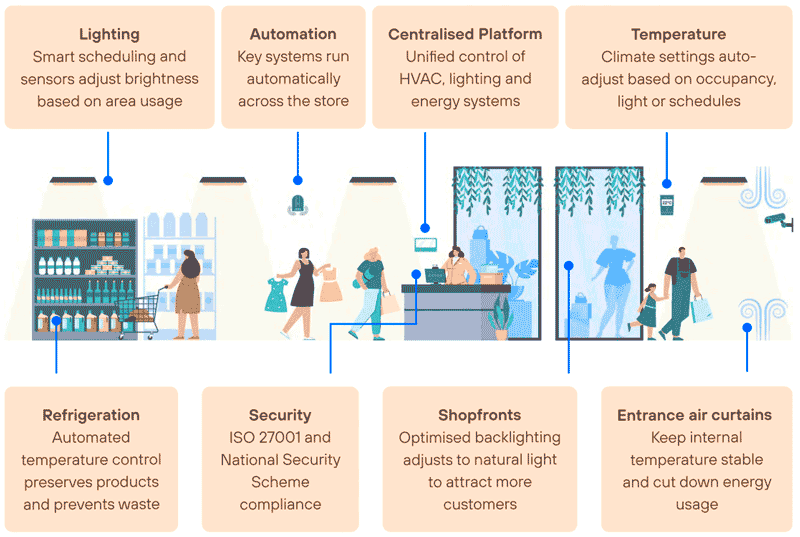What is an intelligent EMS and how it turns energy efficiency into a competitive advantage
Energy efficiency is a clear competitive advantage for businesses, as it reduces operating costs by optimising energy consumption and enables them to offer more competitive prices for their products or services.
It also strengthens corporate reputation by demonstrating a commitment to sustainability, helps meet environmental regulations, and facilitates access to grants and funding. In addition, it provides resilience against fluctuations in energy prices.
The European Union's new energy efficiency directives for buildings state that all buildings, both new and existing, must comply with minimum efficiency standards, progressing towards zero-emission buildings from 2030 onwards.
What is an EMS (Energy Management System)?
EMS stands for Energy Management System, a platform that enables the control of a building’s systems with the aim of monitoring, managing and optimising its energy consumption.
In the Retail sector, the most commonly controlled systems include in-store lighting, window display lighting, HVAC, refrigeration and entrance air curtains. However, other types of systems can also be managed.
There are closed EMS systems, typically provided by manufacturers, which require proprietary hardware and software to operate. On the other hand, there are open EMS systems that rely on communication protocols and standards.
Telefónica Tech’s EMS is an open system, vendor-agnostic, which gives us greater flexibility and enables us to support clients in any situation.
Using an open system like our EMS at Telefónica Tech offers clear benefits for clients as it eliminates dependency on a single manufacturer. This means that businesses can choose devices from any brand at any time, and all equipment can communicate seamlessly, regardless of the manufacturer, thanks to the interoperability enabled by the communication protocol.
This flexibility in sourcing devices from any manufacturer also opens the door to always accessing the most advanced and innovative technology, with nothing standing in the way of full compatibility.
How does it help companies achieve energy efficiency?
With our EMS from Telefónica Tech, we can monitor, analyse and optimise energy usage across an organisation. Energy savings are achieved through real-time monitoring and process automation. Based on an initial data analysis, rules are established to generate energy savings across the various systems.
Telefónica Tech’s EMS enables our clients to manage everything easily and centrally, with all their sites visible on the same platform, allowing for comparisons and mass actions.
Additionally, thanks to Artificial Intelligence, we turn complex tasks into simple ones. For example, clients can generate energy consumption reports by asking a chatbot, or have it review utility bills for potential errors.
Beyond energy efficiency, what other benefits does it offer?
To achieve energy savings, we control systems through communication protocols such as ModBus, KNX or BACnet. By controlling these systems, we can perform remote operation and maintenance across sites.
Remote system management brings numerous benefits, such as continuous monitoring of equipment status, fast fault detection with automatic notifications, partial remote issue resolution and, as a result, lower maintenance costs.
All of this is done in a centralised manner, through a single platform that supervises and operates all of a client’s locations.
Use cases
The use cases for EMS are broad and often tailored to the client’s specific needs. However, some are commonly shared across sectors.
In the Retail sector, the most frequent use cases include:
- Remote management of systems during operations and maintenance, with all stores unified on a single platform.
- Optimising high-consumption systems such as HVAC, in-store and window display lighting, refrigeration units and air curtains at store entrances — resulting in significant energy savings.
- Having a system capable of collecting all energy data, enabling the company to obtain sustainability certifications such as ISO 50001.
Other potential use cases include connecting:
- Photovoltaic energy system to monitor generation and solar energy consumption.
- Battery system to check charge levels in case of power supply interruptions.
- Cleaning machines used in retail to track their location and battery status.
- People counting system to adjust temperature settings based on foot traffic.
Telefónica Tech’s EMS is a multi-protocol, open system that can adapt to the specific needs of each client.
There’s a solution for every challenge
We are currently facing high energy demand driven by technological advancement. At the same time, geopolitical panorama are making energy prices volatile, and we face the ongoing challenge of decarbonisation.
■ Telefónica Tech’s EMS helps companies address all of these challenges by mitigating their impact.
 Hybrid Cloud
Hybrid Cloud Cyber Security & NaaS
Cyber Security & NaaS AI & Data
AI & Data IoT & Connectivity
IoT & Connectivity Business Applications
Business Applications Intelligent Workplace
Intelligent Workplace Consulting & Professional Services
Consulting & Professional Services Small Medium Enterprise
Small Medium Enterprise Health and Social Care
Health and Social Care Industry
Industry Retail
Retail Tourism and Leisure
Tourism and Leisure Transport & Logistics
Transport & Logistics Energy & Utilities
Energy & Utilities Banking and Finance
Banking and Finance Sports
Sports Smart Cities
Smart Cities






